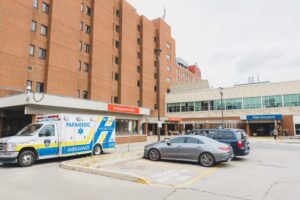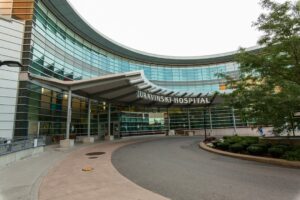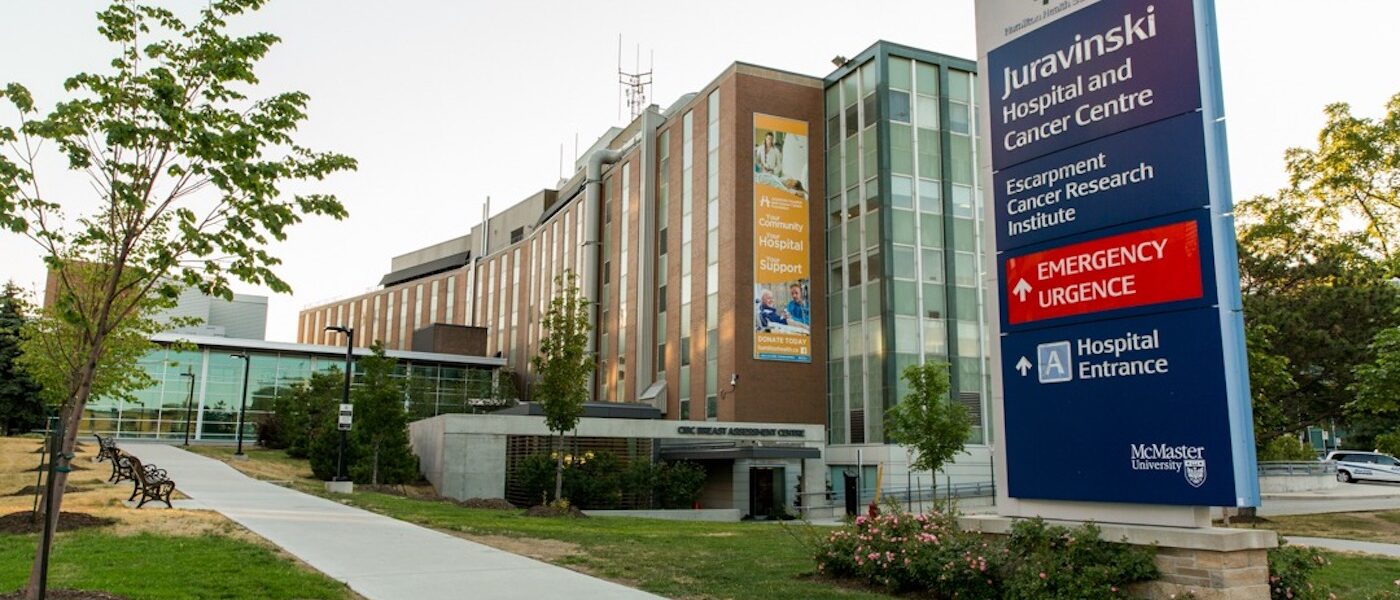
The Hamilton Health Sciences (HHS) Anesthesia Department is a tertiary care academic department composed of four sites and a multidisciplinary pain clinic. Each site has its unique composition of perioperative, pain, and critical care services, offering a valuable clinical and academic experience for undergraduate and postgraduate learners, practicing anesthesiologists, and pain practitioners. The four sites include: the Hamilton General Hospital (HGH), the Juravinski Hospital (JH), McMaster University Medical Centre (MUMC), and West Lincoln Memorial Hospital (WLMH). The DeGroote Pain Clinic is also part of the Department of Anesthesia.
Hamilton Health Sciences’ Anesthesia Department has 65 anesthesiologists, all of whom balance clinical and academic work. Twenty-four thousand operative procedures were completed in 2015, with each of the last five years having comparable numbers. There are 18 geographical full-time equivalents (GFTs), though all anesthesiologists have academic appointments and engage in clinical teaching of medical students and residents. Many contribute in the formal teaching program of both undergraduate and postgraduate medicine. HHS clinical educators, site leaders, subspecialty leaders, and others ensure we maximize educational and clinical experience opportunities. In addition, HHS anesthesiologists are active clinician researchers. It is notable that HHS anesthesiologists are part of multidisciplinary and multi-site research trials with publications in reputable clinical and scientific journals with high-impact factors. These are clinician researchers with full-time clinical practices who still contribute significantly to the research literature and impact upon best practices in anesthesia in perioperative care.
Three of the sites are situated in Hamilton within a short driving distance of each other. Most clinicians work at two of the three sites, while some work at all three sites, according to their subspecialty areas of interest and practice. Residents are generally assigned to services according to site, allowing for focused learning in a familiar environment with consistent teaching, supervision, and feedback.
Expandable List
 The Hamilton General Hospital (HGH) has 13 operating rooms, accommodating services including cardiac surgery, neurosurgery, vascular surgery, trauma services, burns, general surgery, orthopedics (including orthopedic trauma), urology, plastic and maxillofacial surgery, as well as smaller case volumes of adult ear, nose, and throat, and dental surgery. The very busy cardiac surgery service performs a variety of high-risk and routine procedures from elective coronary cardiac bypass to emergent aortic reconstruction, transcatheter aortic valve implementation (TAVI) or replacement (TAVR), and mitral valve clips. Last year, anesthesia provided services for 1800 cardiac cases. All cardiac anesthesiologists are proficient in transesophageal echocardiography and there is a growing interest in transthoracic echo and point of care ultrasound. The neurosurgery service has a large brain and spine surgical patient population. Recently, anesthesia became part of the Endovascular Clot Retrieval Team for emergent management of stroke. The Anesthesia Department was an integral part of the redevelopment of the Interventional Radiology suite and is also involved in the development of two new hybrid operating rooms. Vascular surgery encompasses peripheral vascular as well as endovascular and open aortic aneurysm repair. The large catchment area for trauma contributes to a high volume of multi-trauma patients frequently requiring emergent surgical and anesthesia care. Over 400 trauma cases were managed at the HGH last year. In addition, there is a high volume of orthopedic trauma procedures scheduled on a daily basis. Two operating rooms are dedicated to emergent and urgent work daily with an almost equal amount of after hours OR work.
The Hamilton General Hospital (HGH) has 13 operating rooms, accommodating services including cardiac surgery, neurosurgery, vascular surgery, trauma services, burns, general surgery, orthopedics (including orthopedic trauma), urology, plastic and maxillofacial surgery, as well as smaller case volumes of adult ear, nose, and throat, and dental surgery. The very busy cardiac surgery service performs a variety of high-risk and routine procedures from elective coronary cardiac bypass to emergent aortic reconstruction, transcatheter aortic valve implementation (TAVI) or replacement (TAVR), and mitral valve clips. Last year, anesthesia provided services for 1800 cardiac cases. All cardiac anesthesiologists are proficient in transesophageal echocardiography and there is a growing interest in transthoracic echo and point of care ultrasound. The neurosurgery service has a large brain and spine surgical patient population. Recently, anesthesia became part of the Endovascular Clot Retrieval Team for emergent management of stroke. The Anesthesia Department was an integral part of the redevelopment of the Interventional Radiology suite and is also involved in the development of two new hybrid operating rooms. Vascular surgery encompasses peripheral vascular as well as endovascular and open aortic aneurysm repair. The large catchment area for trauma contributes to a high volume of multi-trauma patients frequently requiring emergent surgical and anesthesia care. Over 400 trauma cases were managed at the HGH last year. In addition, there is a high volume of orthopedic trauma procedures scheduled on a daily basis. Two operating rooms are dedicated to emergent and urgent work daily with an almost equal amount of after hours OR work.
Outside the operating room, services are provided to the Heart Investigation Unit, Interventional and Diagnostic Radiology, Electrophysical Lab, and occasional anesthetic services for other medical and surgical subspecialties. In the areas of critical care, anesthesia participates in consultative and intensivist care in three intensive care units of the Critical Care Department. We provide anesthesia expertise as part of the trauma team as trauma team leaders and members. Anesthesia care is also delivered to the Burn Unit patients by the trauma team. Anesthesia works as part of the operating room team with surgery, nursing, respirology therapy, pharmacy perfusion, biomedical, and other departments and services to carry out patient care from the preoperative to intraoperative and postoperative periods.
 The Juravinski Hospital (JH) site has 9 operating rooms with general and subspecialty services. Oncology surgical procedures include orthopedic, colorectal, hepatobiliary, gynecological, and breast cancer. General surgery and urology procedures add to the total number of approximately 6,800 cases in the JH operating room in the past year. Orthopedic services are primarily major total joint replacements; care of all hip fracture patients is carried out at this site. Outside the operating room, a sedation service is provided for select patients in the interventional Diagnostic Imaging Suite and upon special request elsewhere. Anesthesia has been a key consultant in the design of a new hybrid Diagnostic Imaging Suite under construction on this site. The anesthesia department liaises with both Intensive Care and Coronary Care teams for the perioperative management of high-risk patients, and has a consultative role in the care of most urgent and emergent cases at the JH operating room.
The Juravinski Hospital (JH) site has 9 operating rooms with general and subspecialty services. Oncology surgical procedures include orthopedic, colorectal, hepatobiliary, gynecological, and breast cancer. General surgery and urology procedures add to the total number of approximately 6,800 cases in the JH operating room in the past year. Orthopedic services are primarily major total joint replacements; care of all hip fracture patients is carried out at this site. Outside the operating room, a sedation service is provided for select patients in the interventional Diagnostic Imaging Suite and upon special request elsewhere. Anesthesia has been a key consultant in the design of a new hybrid Diagnostic Imaging Suite under construction on this site. The anesthesia department liaises with both Intensive Care and Coronary Care teams for the perioperative management of high-risk patients, and has a consultative role in the care of most urgent and emergent cases at the JH operating room.
 McMaster University Medical Centre (MUMC) houses the McMaster Children’s Hospital and is the site for pediatric surgical and anesthesia services as well as a small volume of adult outpatient procedures. The Pediatric Anesthesia group is a mix of anesthesiologists with Pediatric Fellowship who provide continuous coverage for high-risk pediatrics and neonates, as well as generalists with experience in pediatrics. Anesthesia services for routine and tertiary-level pediatric and neonatal surgical cases include general surgery, ENT, urology, neurosurgery, orthopedics (including spine), and plastics (including cranial vault reconstruction). Anesthesia provided care for just over 5,000 cases last year with almost 100 of those being neonates. Overall, high-volume pediatric sedation services provides care in three satellite locations: MRI, CT, and Interventional Radiology. In addition, anesthesia care is available on medical units such as hematology, oncology, and GI endoscopy. Sedation nurses, anesthesia assistants, and a nurse practitioner support the pediatric sedation service and the anesthesiologists.
McMaster University Medical Centre (MUMC) houses the McMaster Children’s Hospital and is the site for pediatric surgical and anesthesia services as well as a small volume of adult outpatient procedures. The Pediatric Anesthesia group is a mix of anesthesiologists with Pediatric Fellowship who provide continuous coverage for high-risk pediatrics and neonates, as well as generalists with experience in pediatrics. Anesthesia services for routine and tertiary-level pediatric and neonatal surgical cases include general surgery, ENT, urology, neurosurgery, orthopedics (including spine), and plastics (including cranial vault reconstruction). Anesthesia provided care for just over 5,000 cases last year with almost 100 of those being neonates. Overall, high-volume pediatric sedation services provides care in three satellite locations: MRI, CT, and Interventional Radiology. In addition, anesthesia care is available on medical units such as hematology, oncology, and GI endoscopy. Sedation nurses, anesthesia assistants, and a nurse practitioner support the pediatric sedation service and the anesthesiologists.
The Neonatal Intensive Care Unit is one of the largest in Canada and has a fairly significant neonatal surgical volume per year, including PDA ligations, neurosurgery, thoracic surgery, and laparotomies. The pediatric anesthesia team care for pediatric patients needing investigations or procedures at one of the other HHS sites, such as radiation treatments at the JH and neurointerventional at the HGH. Anesthesia assistants are particularly important to care of high-risk pediatric patients both inside and outside of OR settings.
Adult ambulatory and high-risk gynecological surgical procedures, adult ambulatory general surgery, orthopedics, and plastics procedures are performed at the MUMC site. Adult and pediatric anesthesiologists cover the adult caseload.
The Obstetrical Labour and Delivery Suite is located in the MUMC building as part of Women’s Health Services. There are, on average, 3,200 deliveries performed per year, and approximately 1,800 epidurals are placed. The cesarean section rate is 40%, with about 1% of those being general anesthetics. Approximately 25% of the deliveries are for high-risk pregnancies through the Matherno-fetal Medicine service. These high-risk patients vary from severe maternal illnesses to fetal congenital abnormalities.
 West Lincoln Memorial Hospital amalgamated with HHS in 2014. WLMH has two operating rooms, an obstetrical service, and an emergency room, with anesthesia coverage for all three areas. Current surgical services include gynecology, general surgery, urology, and low-risk obstetrics. The six anesthesia providers at WLMH are General Practice Anesthetists with a practice mix of Family Medicine, Anesthesia, and Emergency Medicine. All of these anesthesia providers have trained through a Family Medicine Anesthesiology Program. All of these anesthesia providers have trained through a Family Medicine Anesthesiology Program and are credentialed accordingly through HHS. A variety of learners attend to WLMH. Medical students and residents rotate through this hospital for anesthesia experience. The Family Practice Anesthesia Group is active in the hospital community, fulfilling roles from Chief of Staff and site leads for the Emergency Department, both of which are active in interdisciplinary education and various hospital committees.
West Lincoln Memorial Hospital amalgamated with HHS in 2014. WLMH has two operating rooms, an obstetrical service, and an emergency room, with anesthesia coverage for all three areas. Current surgical services include gynecology, general surgery, urology, and low-risk obstetrics. The six anesthesia providers at WLMH are General Practice Anesthetists with a practice mix of Family Medicine, Anesthesia, and Emergency Medicine. All of these anesthesia providers have trained through a Family Medicine Anesthesiology Program. All of these anesthesia providers have trained through a Family Medicine Anesthesiology Program and are credentialed accordingly through HHS. A variety of learners attend to WLMH. Medical students and residents rotate through this hospital for anesthesia experience. The Family Practice Anesthesia Group is active in the hospital community, fulfilling roles from Chief of Staff and site leads for the Emergency Department, both of which are active in interdisciplinary education and various hospital committees.

